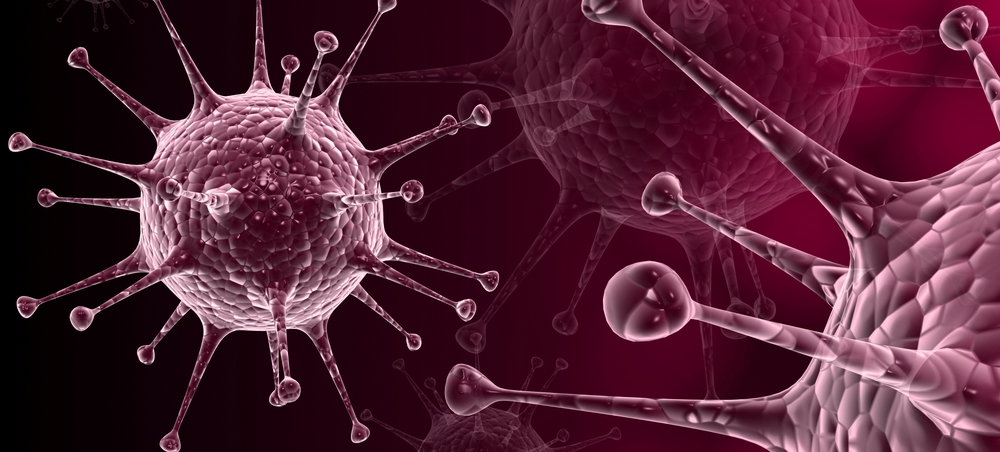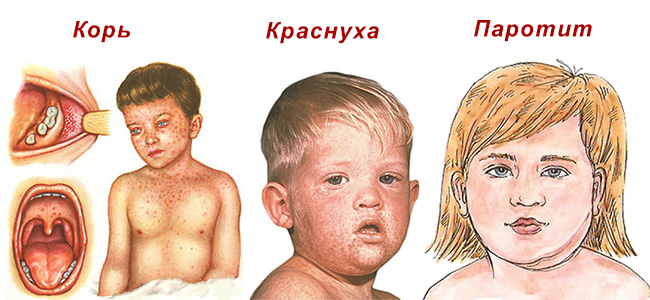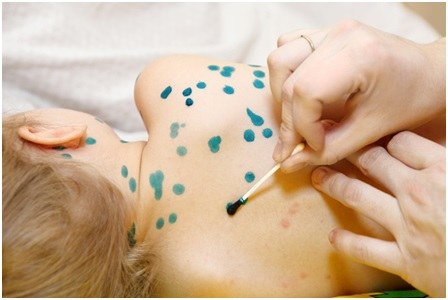There are many childhood infectious diseases caused by viruses, each of which manifests itself differently and requires a separate approach to treatment. And even if some manifestations of diseases are similar, this does not mean that the person’s condition and the consequences of the disease will be the same. Different viruses cause characteristic pathological changes in the body and are especially dangerous due to the complications that arise.

Herpes under a microscope
Since measles and chickenpox are caused by different viruses, they behave differently in the body. Their degree of danger also varies. For example, it is advisable to get chickenpox in childhood, but it is better not to get measles at all, which is why vaccination is carried out.
The manifestations of the disease are similar, but there are also distinctive features. After the infection subsides, the body develops immunity to one or another virus (impossible).
Chickenpox: common symptoms and characteristic differences
The disease develops most actively in the autumn-winter period. Outbreaks are observed in children's and school institutions, and children are getting sick en masse. By the time they reach adulthood, 70% of young people have already had chickenpox and are immune to it. Others can, which is much more difficult to tolerate.
Measles: main signs and characteristics
 The disease is infectious in nature and is caused by an airborne paramyxovirus, which has a 100% ability to infect people who happen to be close to a human carrier.
The disease is infectious in nature and is caused by an airborne paramyxovirus, which has a 100% ability to infect people who happen to be close to a human carrier.
Like any virus, in external damage it forms “dead” crystals, which are capable of developing vigorous activity only inside the body.
The disease spreads seasonally, with a peak between October and April, when people spend most of their time indoors and in close contact with each other. A person with measles is dangerous to others from the moment incubation begins until the end of the development of the disease, which lasts 7-10 days.
The danger of measles is that it causes serious complications. The mortality rate is 150,000 people (usually children under 10 years old) per year. Therefore, vaccination is important to avoid the disease or.

Vaccination is the best way to protect yourself and your children
If a woman is planning a pregnancy, then it is also important for her to get vaccinated, since the fetus or infant can become infected if paramyxoviruses are present in the mother’s blood. Thanks to this, the morbidity rate in children has decreased, which cannot be said about the adult population, so the phenomenon is quite common.

Preventing measles during pregnancy is extremely important
The pathogen enters the body through the respiratory tract and organs of vision. Then he goes through the following path:
- penetrating into cells, it actively multiplies;
- three days later, it enters the spleen through the bloodstream;
- here its reproduction continues throughout the incubation period;
- then “hordes” of viruses settle inside the body: on the skin, in the conjunctiva, gastrointestinal tract, respiratory and nervous systems.
Symptoms of measles may differ slightly, depending on age, physiological characteristics of the body, and the state of the immune system. Common manifestations of infection are as follows:
- signs of a cold: fever, cough, weakness, runny nose;
- intoxication is observed;
- then an inflammatory process of the eye mucosa appears;
- after 2-4 days, whitish rashes are found on the mucous membrane of the cheeks;
- from the 5th day a rash in the form of bright spots appears behind the ears and on the forehead, later it covers the whole body;
- red spots grow, take on an irregular shape and merge;
- when the rash is at its maximum, there is a high (up to +40C) temperature;
- after 4-7 days, the rash begins to disappear, being replaced by age spots, which disappear after a couple of weeks.
A person who has recovered from the disease develops strong immunity. Repeated infections occur due to immunodeficiency of the body.
The most significant distinguishing features of measles and chickenpox
Since diseases are caused by different viruses, it is obvious that their manifestations will differ. Let's look at the main ones using a comparative table as an example.
Table “Signs of measles and chickenpox: differences”
| Signs of chickenpox | Signs of measles |
| pathogen – | causative agent – paramyxovirus |
| does not survive in the external environment | survives at extremely low temperatures |
| the virus settles in the respiratory system | route of penetration - respiratory and visual organs |
| the disease begins with signs of a cold | onset of the disease – pain in the abdomen and head, general weakness |
| the rash disappears after a week, leaving small scars that fade over time | the rash goes away after a week and in its place pigment spots form, which gradually fade and disappear |
| It is advisable to have a mild illness in childhood | It is advisable not to get sick at all by getting vaccinated |
In both forms, diseases sometimes occur. More often than not, the infection itself is not as scary as the consequences it can lead to.
Is measles rubella?
 Measles and rubella are similar in many of their manifestations, but they are different diseases. These are acute infections that are transmitted by airborne droplets. They are well tolerated in childhood and difficult when a person is already an adult. There are similarities in the manifestations of diseases.
Measles and rubella are similar in many of their manifestations, but they are different diseases. These are acute infections that are transmitted by airborne droplets. They are well tolerated in childhood and difficult when a person is already an adult. There are similarities in the manifestations of diseases.
But rubella is caused by another virus from the Rubivirus genus, and accordingly it behaves somewhat differently. Rubivirus remains viable in the external environment for only a few hours and is not killed by freezing, so it can sometimes be transmitted through household means. Compared to measles, closer contact with the carrier of the virus is required.
The disease can occur with pronounced clinical symptoms and in a latent form. The pathogen is released through droplets of moisture during breathing, urine, and feces.
 The incubation period is quite long: 10-25 days. Women of childbearing age (20-29 years) are susceptible to this infection. The virus enters the body through the upper respiratory tract or damaged skin.
The incubation period is quite long: 10-25 days. Women of childbearing age (20-29 years) are susceptible to this infection. The virus enters the body through the upper respiratory tract or damaged skin.
The localization site of the rubivirus is the lymph nodes, where it multiplies and undergoes multiple quantitative growth, and then begins its migration within the body through the bloodstream. After an infection, immunity to it is developed.
Manifestations of the disease are as follows:
- cold symptoms plus lacrimation and photophobia are observed for three days;
- the lymph nodes become inflamed, becoming painful to the touch;
- then a rash begins and appears on the face and neck;
- the rash spreads throughout the body and persists for 4 days.
The rash is small, pink or red. The edges of the spots are smooth, the skin around does not change. In adults, the spots may merge; this is not typical for childhood rubella. Adults exhibit the same symptoms as children, but the disease is more severe and longer lasting.

What you need to know
After rubella, complications sometimes occur; they rarely manifest themselves in the form of rubella encephalitis or arthritis.
Pregnant women should not get rubella, since viruses infect the fetus, cause mutations at the gene level, and there is no talk of the birth of healthy offspring.
Comparison of three viral infections: chickenpox, measles and rubella
Let's try to figure out what infectious diseases have in common and how they differ using a comparative table.
Table “Similarities and differences between chickenpox, measles and rubella”
| Chickenpox | Measles | Rubella |
| Differences | ||
| caused by the herpes virus | caused by paramyxovirus | caused by rubivirus |
| incubation period – 10-21 days | incubation period – 7-17 days | incubation period – 10-25 days |
| rashes in the form of spots with a red rim and white contents inside | red, bright rashes that enlarge and may coalesce. | small red or pink round rashes with smooth edges |
| the virus settles in the respiratory tract | The virus enters the body through the respiratory and visual organs | the virus enters through the respiratory system or skin |
| Similarities | ||
| approximately the same progression of the disease | ||
| transmission route: airborne | ||
| lasting immunity after recovery | ||
| the disease occurs in a mild form in childhood and with strong immunity | ||
| Complications are possible after illness | ||
| transmission of the virus occurs through contact with its carrier in 100% of cases | ||
It is necessary to get a routine vaccination against measles and rubella. There is no vaccination against chickenpox; it is recommended that you get it in childhood.
Treatment
 There is no special treatment for these infections; children usually tolerate the disease quite easily. They must be under constant parental supervision. General treatment focuses on reducing the irritating symptoms of the disease.
There is no special treatment for these infections; children usually tolerate the disease quite easily. They must be under constant parental supervision. General treatment focuses on reducing the irritating symptoms of the disease.
Practiced:
- bed rest or gentle rest,
- and frequent drinking
- tracking the development and duration of skin rashes.
In case of severe diseases, antipyretics, sedatives, and antihistamines are used. For chickenpox it is used.
After an illness, the body remains weakened for a long time, so it is advisable to isolate the child for 2 weeks so that he does not “catch” a new infection. Despite this fairly simple treatment, it is important that the attending physician monitors its progress.
Many parents tend to self-prescribe to their children, which is not only dangerous, but also completely pointless, since they have no effect on viruses. They are effective only against bacteria.

Don't overdo it with care
Thus, all of the above infectious diseases are curable and their outcome is favorable if the doctor’s recommendations are followed. Despite some similarity of symptoms, you can easily distinguish chickenpox from measles, especially after reading our article.


